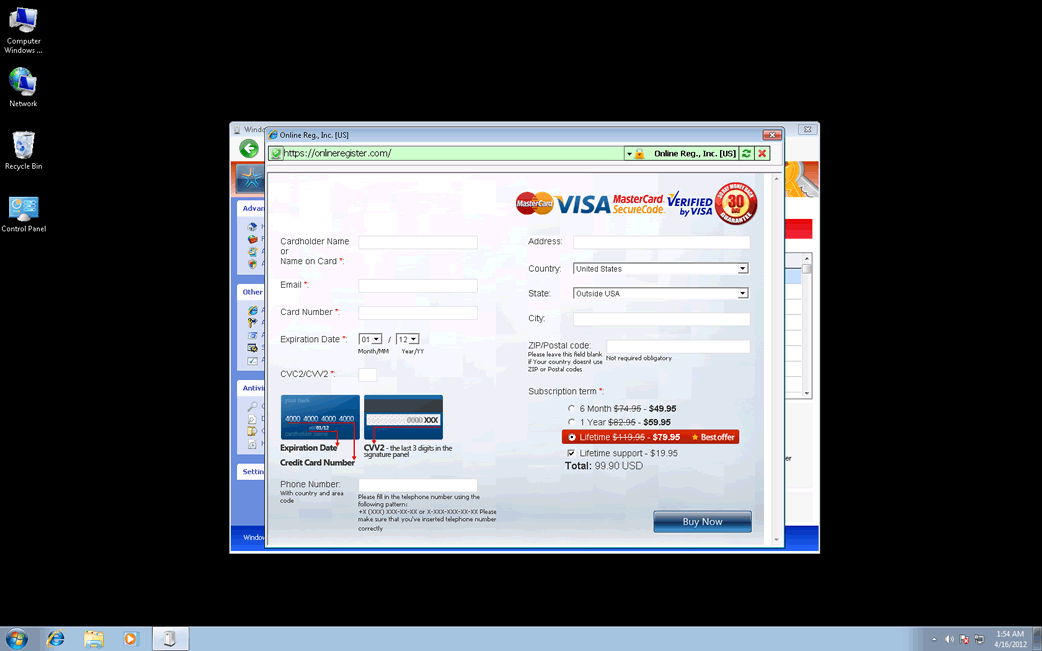Windows Crucial Scanner
Threat Scorecard
EnigmaSoft Threat Scorecard
EnigmaSoft Threat Scorecards are assessment reports for different malware threats which have been collected and analyzed by our research team. EnigmaSoft Threat Scorecards evaluate and rank threats using several metrics including real-world and potential risk factors, trends, frequency, prevalence, and persistence. EnigmaSoft Threat Scorecards are updated regularly based on our research data and metrics and are useful for a wide range of computer users, from end users seeking solutions to remove malware from their systems to security experts analyzing threats.
EnigmaSoft Threat Scorecards display a variety of useful information, including:
Ranking: The ranking of a particular threat in EnigmaSoft’s Threat Database.
Severity Level: The determined severity level of an object, represented numerically, based on our risk modeling process and research, as explained in our Threat Assessment Criteria.
Infected Computers: The number of confirmed and suspected cases of a particular threat detected on infected computers as reported by SpyHunter.
See also Threat Assessment Criteria.
| Ranking: | 4,501 |
| Threat Level: | 10 % (Normal) |
| Infected Computers: | 739 |
| First Seen: | April 14, 2012 |
| Last Seen: | September 20, 2023 |
| OS(es) Affected: | Windows |

Windows Crucial Scanner Image
Windows Crucial Scanner is part of a large batch of malware in the FakeVimes family that was released in 2012. According to ESG Security analysts, Windows Crucial Scanner has no actual anti-virus effectiveness and is part of a common online scam. The FakeVimes family of malware is a notorious family of rogue anti-spyware programs that have attacked computer systems since 2009. The batch of FakeVimes clones that include Windows Crucial Scanner is particularly dangerous because of the inclusion of a rootkit component, often a variant of the Sirefef or ZeroAccess rootkit. This makes rogue anti-virus programs released in 2012 (such as Windows Crucial Scanner) to be particularly difficult to remove. Like previous versions of malware in this family, Windows Crucial Scanner uses file names containing a characteristic string comprised of three random letters.
Windows Crucial Scanner also has the capacity to detect file processes associated with known security applications and attempt to stop them. Examples of malware in the Windows Crucial Scanner family include programs with names like Virus Melt, Presto TuneUp, Fast Antivirus 2009, Extra Antivirus, Windows Security Suite, Smart Virus Eliminator, Packed.Generic.245, Volcano Security Suite, Windows Enterprise Suite, Enterprise Suite, Additional Guard, PC Live Guard, Live PC Care, Live Enterprise Suite, Security Antivirus, My Security Wall, CleanUp Antivirus, Smart Security, Windows Protection Suite, Windows Work Catalyst.
Thanks to the fact that clones of Windows Crucial Scanner have been around for several years, most security programs have no problem handling a Windows Crucial Scanner infection. However, the removal of its associated rootkit will usually require the help of a specialized application for rootkit removal.
Table of Contents
How Windows Crucial Scanner is Used to Attempt to Steal Your Money
The Windows Crucial Scanner scam consists in trying to convince computer users that their computer system is under attack by a horde of Trojans and viruses. This is done through the use of authentic-looking error messages and security alerts designed to alarm the victim. Then, Windows Crucial Scanner directs the victim's web browser or uses additional pop-up messages to lead the victim to purchase a supposed 'full version" of Windows Crucial Scanner. Windows Crucial Scanner claims that Windows Crucial Scanner cannot remove these supposed malware infections in the victim's computer unless a registration code is entered into its interface.
ESG security analysts have found that entering a registration code will stop most of the error messages, but will not remove the Windows Crucial Scanner infection itself. However, this can aid in removing this malware threat from the infected computer system. The registration code 0W000-000B0-00T00-E0020 can be used to aid in Windows Crucial Scanner's removal, although it is crucial to note that as long as Windows Crucial Scanner remains on the infected computer system Windows Crucial Scanner will continue to cause problems and expose the victim's computer to additional malware infections.
Windows Crucial Scanner Video
Tip: Turn your sound ON and watch the video in Full Screen mode.

File System Details
| # | File Name |
Detections
Detections: The number of confirmed and suspected cases of a particular threat detected on
infected computers as reported by SpyHunter.
|
|---|---|---|
| 1. | %AppData%\Protector-[RANDOM 3 CHARACTERS].exe | |
| 2. | %AppData%\NPSWF32.dll | |
| 3. | %Desktop%\Windows Crucial Scanner.lnk | |
| 4. | %CommonStartMenu%\Programs\Windows Crucial Scanner.lnk | |
| 5. | %AppData%\result.db |

